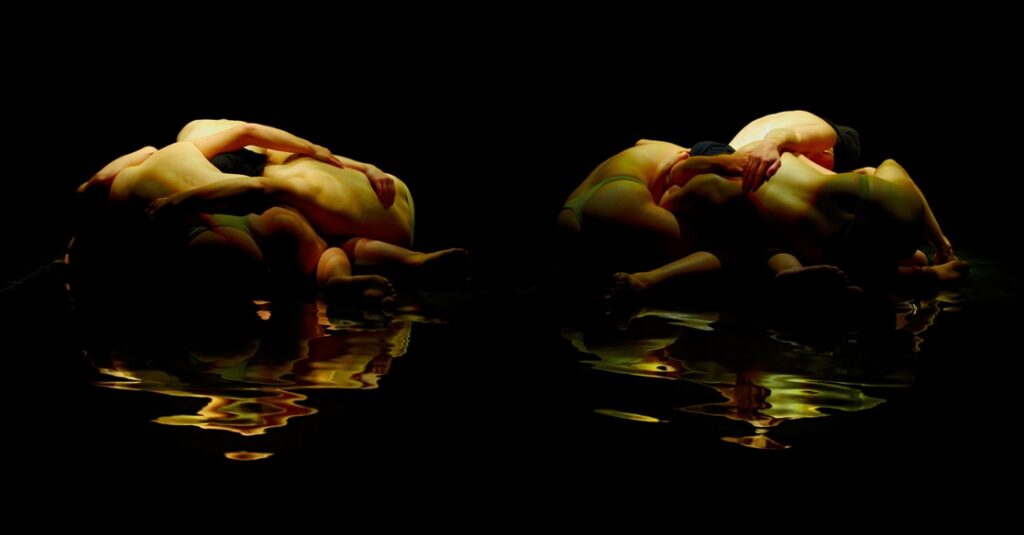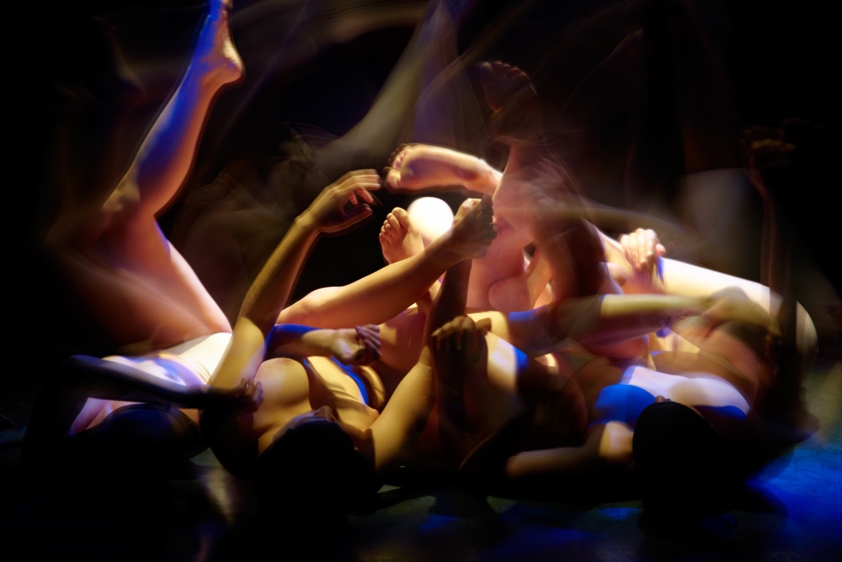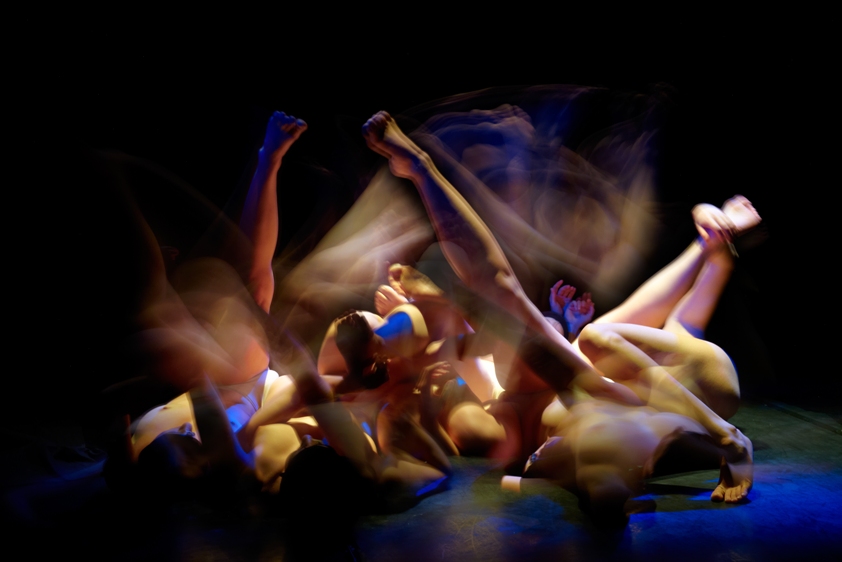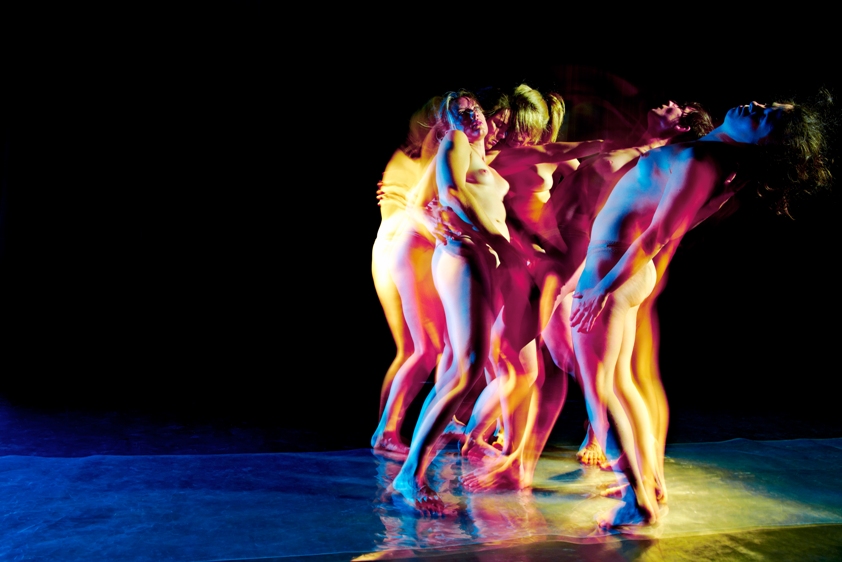In an increasingly digital world, it should come as no surprise that digital technologies have infiltrated the landscape of contemporary performance, redefining its practices and discourse, while proposing alternative approaches to performance-making and composition. The integration of technology in performance has moreover challenged the very notions of stage and representation, and, importantly for this article, the perception, figuration and performativity of the body. On this last point, questions of mediation and the mediated body have particular ramifications in dance, a discipline which has traditionally upheld the primacy of the live body in performance. If as one critic notes, « A digital body (…) operates alternately as a weightless shell, as a translation of physical materiality into a controllable code (…) the occidental image of a smooth, moldable [sic] and controllable body (…) structurally unfettered, multiple and boundless in its imaginative/fantastic possibilities » (Begusch, 1999), the mediated body in Isabelle Choinière’s work resists such description, shunning all possible instrumentalization of the body by technology (Choinière, 2013), and, on the contrary, placing the tangible, sensate body at the centre of its aesthetic proposition.

Advance publicity for Choinière’s latest production, Flesh Waves, promotes the work as « digital dance »; however, here, no virtual bodies are to be seen floating around on screens or a backdrop, nor are spectators invited to interact with digital avatars. Seated around the periphery of a six-meter wide circular stage occupied by five almost entirely nude female dancers, audience members become unwittingly enmeshed in an unusual, even provocative, immersive experience of a sensual, experiential nature.
Echoing Maurice Merleau-Ponty’s vision (Merleau-Ponty, 1945) of being in the world as a constant exchange between the sensing body and all that is external to it, Flesh Waves integrates technology as an exteroceptive agency stimulating new sensory-perceptual activity and expressive potentialities, and in parallel, as a means to amplify a somatic exchange of real bodies-to-bodies: amongst the dancers onstage, and between performers and spectators.
Today, neuroscience confirms that if perceptual experience depends on sensory perceptors – each with specific functions that allow humans to register different sensations – no single type of sensor is ever active at any given time, and further, that if necessary, one sense can step in for, or replace, another form of sensory input1. A similar condition of interconnection and interdependency of the senses is revealed through the phenomenon of synaesthesia – another form of sensory substitution – in which stimulation of one sense or cognitive pathway triggers involuntary sensations in a second sensory organ or cognitive pathway. In the performing arts, this phenomenon – whether constituting an intended aesthetic strategy or not – commonly plays out as a form of haptic touch or kinaesthetic empathy wherein touch, or alternately, the embodied quality of movement, can be communicated and understood by spectators vicariously, physically, through the senses of sight and sound.
In creating the conditions and a specific mediated environment for establishing an empathic sensory relationship of bodies-to-bodies, lsabelle Choinière develops strategies that both deflect the cognitive act seeking to identify a pure choreographic form or narrative mode, and temper, if not neutralize, the voyeuristic or eroticized gaze between subject and object. Proposing a « communion » of a « vibratory » nature, or what she defines as an « interfaced intercorporeality » (Choinière, 2013), she aims to install what various theorists (Sheets-Johnstone 1990, Shusterman2009, Formis 2009)2 have called « le penser en corps »: thinking through the body. Staging the female body as both a subject and abstract expression of the flesh in all its volume(s), sensuality and excess, Choinière invites spectators to engage in a mode of relational seeing which draws upon and also « touches » the viewer’s somatic sensibility3 a form of embodied understanding or proprioceptive relationship to what is seen and felt.

With this mise en abyme of the performing body, Choinière neither seeks to underscore a question of identity – of the desiring machine, or the personal, sexual, cultural, political or cyborg body – nor to highlight dance movement per se. Again, what is at stake is the exposition and communication of a somatic perceptual experience akin to the Merleau-Pontian « corps propre » (Merleau-Ponty, 1945) (the body itself); here, articulated through an abstract choreographic textural language and the design of a spectatorial experience moving away from an ocularcentrist perspective to rather summon bodily intelligence, or what Erin Brannigan, in her book Dance Film: Choreography and the Moving Image (2011), has referred to as « a model of corporeal experience that places the body at the site where the thrust of the actus meets its mark – where ‘feelings’ are registered that provide knowledge of the unnamed » (Brannigan, 2011, p. 185).
Barely visible in a pool of light, a mass of flesh, formed by dancers whose limbs and torsos mingle and interweave, slowly evolves with micro-movements before rising to the standing position in an exploration of surrounding space. The entity’s presence radiates outwards energetically, attaining spectators by virtue of an act of « contamination »4. Proximity to whispering, moaning bodies that are almost entirely naked, reinforced by the hall’s darkness and an aural environment in 360° emitting both sound and vibrations, has the cumulative effect of piercing spectators’ intimate physical and psychological space and favouring a more direct contact and connection with action unfolding before them. Hypnotized and « touched » in the flesh, they can either respond by letting themselves be lulled by this invasive sensory « bath » or attempt to resist its effect.

Spectators are nonetheless caught within a play of mediated elements constituting an enveloping, multi-sensorial environment. For if Choinière has chosen to place emphasis on the fleshly, both the body and time-space have dilated, resonating and vibrating in waves. More precisely, space itself becomes a medium or vector for extending and diffusing the body-subject as an all-encompassing environment. As a result, the affective, collective and experiential dimensions of live performance are magnified through the effects of mediation and immersion on perception. On the one hand, spatialized sound coming from all directions amplifies and projects the intimate body into space: that is, the murmurs, rustlings and groans of the dancers who themselves generate a sound score in real-time through their individual and collective voices, bodily contact and movement. As Italian researcher Enrico Pitozzi explains,
« The viewer is immersed in a continuous vibration, in a segment of sound as gesture, and it is on this scale of variations that attention should be placed (…) This composition (…) requires a synaesthetic mode of observing and listening, an active and contemporary relationship of the senses » (Pitozzi, 2010).
On the other hand, rather than prosaically referring to this type of mediation as interactive sound, Choinière prefers to speak in terms of the creation of a « collective carnal body » and a « collective sound body », together forming a « collective mediated body5 ». Establishing a continuum in time-space, comprised of the dancers’ gestures/sounds and the spatialized aural environment – together producing the equivalent of an invisible sixth dancer with its own omnipresent dynamic, temporality and spatiality – this resonance extends to solicit and activate the somatic perception of spectators. A different performative mode and form of presence develops: for Choinière, a model of « interfaced intercorporeality » (Choinière, 2013).

Inspiration for the work derived from an eclectic and composite range of sources including Choinière’s initial research into Indian cosmology, Cubism, the works of Hans Bellmer and the Brazilian martial-arts-dance form Capoeira, all contributing to orient, shape and colour the work’s particular aesthetic and dynamic. However, the desire to create and test a model of interfaced intercorporeality was principally guided by her interest in the participative, experiential and multi-sensorial works of Brazilian artist Lygia Clark (1920-1988) and, in particular, Clark’s advocacy of a dissolution of psycho-corporal boundaries and symbiotic intercommunication of bodies in/with other bodies through art and therapy (Brett, 2004). Emphasis on sensory perception, direct individual experience and a blurring of boundaries between the internal/external, subjective/objective, individual/collective were thus essential aspects of Clark’s art and are equally present in Choinière’s Flesh Waves6.
A second influence, again Brazilian, came from the writings of psychoanalyst, art critic, curator and philosopherSuely Rolnik and in particular, her theory of an inter-subjectivity of communication, elaborated after Oswaldo de Andrade’s concept of « canibalismo » or « cultural cannibalism7 » and her analysis of what she calls the animal-body (« corpo-bicho »), the vibrating body (« corpo-vibrátil ») and the egg-body (« corpo-ovo ») in Lygia Clark’s work8. As Rolnik notes, « Birds and lions inhabit us, says Lygia – they are our animal-body. The vibratory body, sensitive to the effects of the movement of universal flows traversing us. The egg-body in which unknown intensive states germinate, provoked by new compositions that ebbs and flows make and break 9». Remarking the inherent tension of these states, which she interprets as being capable of engendering « new forms of existence » and « a criterion for distinguishing modes of subjectivity », Rolnik advances the possibility of inter-subjectivity when, « in the minimal point of materiality of the object, where there is nothing but the embodiment of transmutation that took place in its subjectivity (…) the object reaches its maximum power of contagion10 ».
Contagion – or the contamination of subjectivities by other subjectivities – is a vector of transformation for Clark. For Rolnik, it becomes a technique of survival in the context of an electronic world of deterritorialized subjectivities. Developing the notion of cultural cannibalism in tagion – or the contamination of subjectivities by other subjectivities – is a vector of transformation for Clark. For Rolnik, it becomes a technique of survival in the context of an electronic world of deterritorialized subjectivities. Developing the notion of cultural cannibalism in « Anthropophagic Subjectivity » (1998) and later, in « Molding a Contemporary Soul: The Empty-Full of Lygia Clark » (1999), she proposes a vision of contemporary reality as a collective state of vibrating intersubjectivity in which individuals « surf (…) an ocean of variable flow: fluctuating totalities, in a constant becoming, that each one (individual or group) builds up from the flows that touch its body and its selective filtration operated by desire11». Contact with other vibrating bodies « mobilizes affects as changing as the variable multiplicity that constitutes otherness12 ». Their constellations form « a reality of sensations, corporeal reality, which, though invisible, is no less real than visible reality and its maps. It is the world composing itself over and over, uniquely, in the subjectivity of each person (…) inseparably linked: between me and the other, nonparallel becomings of each person are unleashed in an endless process13 ».

In her quest for a performative form capable of expressing this interconnectivity and complexity, Choinière explores these themes quite literally: through sensate bodies in intercommunication. As its title suggests, Flesh Waves evolves to the rhythm of breaths, small movements and physical agitations which emanate from the mass of interconnected flesh and then extend outwards through mediation as vibrations – or flows of energy. Without mediation, the desired « communion » as a somatic-based exchange of energy and interdependent, experiential moment of subjectivity cannot occur. Effectively, the body in contact with technology becomes a mediated body; a hybrid entity transformed by the encounter of the proprioceptive body with technological exteroception that provokes a reorganization of the body’s habitual sensory mappings. For dancers and choreographers, technology not only constitutes a new working environment and laboratory of experimentation, but also, the means through which to access and develop new levels of proprioceptive awareness, skills – or techniques – and qualities of movement. In short, a new corporeality. This transformation and new modus operandi forcibly exert their influence on the emerging choreographic form and its reception. Based on the premise that dancers can indeed generate and communicate a new interfaced corporeal experience, Choinière’s model of an « interfaced intercorporeality » takes on its full expression when extending to include spectators in a shared experience of mediated inter-subjective corporeality.
Conclusion
Tracing historical developments in dance of the past century and taking into account the body as a « dispositif »(device), art critic Bojana Kunst remarks that the emancipation of the dancer’s voice and the expression of the body « from within » constitute two major contributions of twentieth-century dance. As she notes,
« It seems that 20th century body discovers (…) the true power of the voice coming from within (…) Not only is this kind of voice connected with the fact that the dancing body opens its mouth (and speaks out), but especially with the abolishment of the kinaesthetic hierarchy of movement, which stands for a different temporality and autonomy of the moving body (…) The body listens to its own self (and at the same time, stands still rather than dances)14 »
From pioneers like Duncan to postmodern dance, choreography was eventually freed from an outmoded vision of the silent dancing body locked into strictly observed canons of technique, vocabulary, aesthetic and form. It is not a coincidence that postmodern dance in particular, influenced as it was by emerging somatic practices of the day, was to incorporate an understanding of self and proprioceptive, kinesthetic experience via the training and choreographic approaches of artists such as Yvonne Rainer, Anna Halprin, Steve Paxton and Trisha Brown amongst others.
For Kunst, the body, or dare we say « the body itself », becomes a site of discourse:
The invisible insides of the body seem to get externalized; only in this way are they exposed to the Other and its gaze. The resistance against language, the listening to one’s own self and the establishment of the autonomy of movement also cut deeply into the traditional relationship with the observer as well as into the relationships of power in the dispositif of dance (…) The discovery of the inner sonority of the body, of the autonomy and transmission of its voice seems to me that more intriguing. It is namely not only about an aesthetic strategy but can also be read in a wider sense – as a demand for the acquisition of voice, as an articulation of the body’s audibility, or as a disclosure of the voice of a different corporeality (…) The audibility of the body in contemporary dance and art is namely closely connected with the emancipatory stance towards the body and subjectivity and also extends to the field of the political15.
What is relevant for the present analysis is the potential for « a different corporeality » or, more precisely, different corporealities, to be expressed, along with the possibility of new relationships of the observer with dance. If contemporary dance was to initiate these changes, the advent of digital interfaces several decades later would propel choreographers to go a step further in pushing, blurring and sometimes eradicating boundaries between the inner/outer body, dancer/audience, creator-conceptor/spectator via devices that tend to amplify, juxtapose, simulate and/or directly engage dancers and spectators alike in new sensory-cognitive experiences.
Writing from a decidedly twenty-first century perspective, Erin Manning remarks that,
Sensing bodies in movement are open systems that reach toward one another seemingly, becoming through these relational matrices. As these bodies individuate relationally, they evolve beyond their ontological status, becoming ontogenetic. Technogenesis is the dynamic becoming of the sensing body in movement (…) It is technogenetic because it recomposes the body. This recomposition takes form through a multiplicity of techniques. For Simondon (1969), a technique is a technology of emergence (an ontogenetic technology or technogenesis) through which new complex systems are composed. These techniques can be thought as associated milieus of potential. Associated milieus are ecologies that emerge through the very technogenesis that gives them form (Manning, 2009, p. 66,71).
Technogenetic agencies – techniques, devices, networks and even theories – are indeed changing understandings and relationships to the body, but also of the body, perception and the world at large. In the arts, digital mediation has generated new aesthetic paradigms affecting representation, enunciation, narratology, composition and the reception of works, some of which have been alluded to in this article. As for evoking a particular « ecology » of technogenisis, questions of affiliation, field, territory, relationship and resonance are necessarily raised by the emergence of new media practitioners, most often signified through a new digital logic, language and discourse. While certain choreographers of Choinière’s generation, constituting what is diversely dubbed as a field of « dance and technology », « digital dance » or « dance and new media », have adopted new media for expressly aesthetic motives and/or scenographic enhancements alone, Choinière has remained faithful to her roots as a dancer; that is to say, to the dancer’s accrued understanding of corporeality as a basis for artistic practice in general, and with technology, in particular. From the outset of her career, she has defended Manning’s idea of a « dynamic becoming of the sensing body in movement [as it] recomposes the body »: through developing new modalities of choreographic expression, performativity and corporeal transformation linked with technology, and specifically, of technological mediation with respect to the proprioceptive body. Anchoring her approach in corporeality, while also exploring the creative potentialities of digital technology, she adopts an integrative approach that seeks to subvert « stage conventions, along with their sensory codes of reference, in order to reinvent together our common experience of the meeting place that is live theatre16 ».
As the lights dimmed after the final moments of Flesh Waves, audience members sat motionless in silence for several minutes in the grip of this unusual form of transmission-communion. A Zen-like peace seemed to reign. Pointing towards the endless cycle of the movement of life and art in their respective permutations, might this configuration of sensitive, mediated and inter-connected bodies not be an auspicious sign of dance in the twenty-first century? Or what Rolnik refers to as « a new reality of sensations (…) a map for the future world that takes form in [the artist’s] work (…) Through the practice of art, a semiotic activity of human experience in its becomings, life affirms itself… » (Rolnik, 1999).
Notes
[1] Helen Phillips, « Senses special: The feeling of color », New Scientist, no. 2484, (29 January 2005), p.40 : « … any idea that sensation depends on a particular sensory organ to capture information is under question ».
[2] Maxine Sheets-Johnstone, The Corporeal Turn: An Interdisciplinary Reader, Exeter, Imprint Academic, 2009.
Richard Shusterman, « PENSER EN CORPS, Éduquer les sciences humaines : un appel pour la soma-esthetique » / « Thinking through the Body, Educating for the Humanities: A Plea for Somaesthetics », PENSER EN CORPS,Soma-esthetique, art et philosophie, Ed. Barbara Formis, (Collection « L’Art en bref), Paris, Ed. L’Harmattan, 2009, pp. 41-76.
Barbara Formis, « La Pensée du corps »/« Bodily Thinking », PENSER EN CORPS, Soma-esthetique, art et philosophie, Ed. Barbara Formis, (Collection « L’Art en bref), Paris, Ed. L’Harmattan, 2009, pp. 9-19.
[3] To paraphrase a description by choreographer-director Ali East speaking of a similar reception of her film Soma(2005), analysed in « Sensuous interfaces – Dancing Anima in Aotearoa New Zealand », Somatics and technology,a special issue of Journal of Dance & Somatic Practices, vol.5, no. 1, (Fall, 2013), Eds. Andrea Davidson and Sarah Rubidge, p. 67 : « It is an exercise in relational seeing that is received instantaneously as somatic affect by the viewer’s somatic sensibility ».
[4] Isabelle Choinière, op.cit. With this term, Choinière makes reference to Brazilian artist Hélio Oiticica’s aesthetic of subversion and cultural contamination, later picked up by philosopher-art critic Suely Rolnik (see p. 5 and also note 20).
[5] Isabelle Choinière, « To the modification of corporality that generates corporeality », paper at the METABODY Media Embodiment Tékhne and Bridges of Diversity Conference 2, CYNETART Festival, Festspielhaus Hellerau, Dresden, Friday, Nov. 15th [accessed 15/10/2016].
[6] Clark actually called one of her post-Caminhando stages Fantasmática do corpo or Corpo-coletivo (The Collective-Body).
[7] Suely Rolnik, « Anthropophagic Subjectivity », Arte Contemporanea Brasileira Um e / between Outro/s, Fundação Bienal de São Paulo, 1998. The original term was created by Oswaldo de Andrade in « O Manifesto Antropófago » /« The Cannabilist Manifesto »), Revista de Antropofagia, (1928), English translation by Leslie Bary, 1991.
[8] Suely Rolnik, « Lygia Clark’s Hybrid »/« L’hybride de Lygia Clark » (1997), [accessed 14/08/14].
[9] Ibid. « Des oiseaux et des lions nous habitent, dit Lygia – ils sont notre corps-bête. Corps-vibratile, sensible aux effets du mouvement des flux des univers qui nous traversent. Corps-oeuf, dans lequel germent des états intensifs inconnus provoqués par les nouvelles compositions que les flux, se promenant de ci de là, font et défont».
[10] Ibid. « De temps à autre, la germination s’accumule à tel point que le corps ne parvient plus à s’exprimer en sa figure actuelle. C’est l’inquiétude: la bête grogne, trépigne et finit par être sacrifiée; sa forme devient son suaire (…) Mais, par quoi exactement devrions-nous nous laisser prendre? Par la tension entre la figure actuelle du corps-bête qui insiste par force d’habitude, et les états intensifs qui s’y produisent irréversiblement, exigeant la création d’une nouvelle figure (…) La capacité à habiter cette tension, peut constituer un critère pour distinguer les modes de subjectivation. Un critère éthique, car fondé sur l’expansion de la vie, celle-ci se produisant dans la production de différences et dans leur affirmation de nouvelles formes d’existence ».
[11] Suely Rolnik, « Anthropophagic Subjectivity », Arte Contemporanea Brasileira Um e / between Outro/s, Fundação Bienal de São Paulo, 1998.
[12] Suely Rolnik « Molding a Contemporary Soul: The Empty-Full of Lygia Clark », 1999, ,[accessed 15/01/2016].
[13] Ibid.
[14] Bojana Kunst, « The Voice of the Dancing Body », Frakcija, Zagreb, 2009. [accessed 15/02/2015].
[15] Ibid.
[16] Isabelle Choinère, unpublished project notes communicated in an interview with the author in July 2013.
Bibliographie
– Begusch, Harald, « Shells that Matter. The Digital Body as Aesthetic/Political Representation », Performance Research, vol. 4, no 2, 1999, pp. 30-32, en ligne, <https://www.tandfonline.com/doi/abs/10.1080/13528165.1999.10871662?tab=permissions&scroll=top>.
– Brannigan, Erin, Dance Film: Choreography and the Moving Image, New York, Oxford University Press Inc., 2011, 256 p.
– Brett, Guy, Carnival of Perception: Selected Writings on Art, London, Institute of International Visual Arts, 2004, 264 p.
– Choinière, Isabelle, « For a methodology of transformation at the crossroads of technology and somatics: Becoming another… », Somatics and technology, a special issue of Journal of Dance & Somatic Practices, vol. 5, no 1, 2013, p. 95-112, en ligne, <https://www.intellectbooks.com/journals/view-issue,id=2562/>.
– Choinère, Isabelle, « For a methodology of transformation at the crossroads of technology and somatics: Becoming another… », Somatics and technology, a special issue of Journal of Dance & Somatic Practices, vol.5, no 1, 2013, pp. 95-112, en ligne, <https://www.intellectbooks.com/journals/view-issue,id=2562/>.
– Manning, Erin, Relationscapes: Movement, Art, Philosophy, Cambridge, MIT Press, 2009, 268 p.
– Merleau-Ponty, Maurice, Phénoménologie de la Perception / Phenomenology of Perception, Paris, Gallimard, 1945, 278 p.
– Pitozzi, Enrico, « Corpo sonoro collettivo. Verso una tattilita uditiva » / « The Collective Sound Body. Towards an auditory tactility », Digimag, no 51, février 2010.
– Rolnik, Suely, « Molding a Contemporary Soul: The Empty-Full of Lygia Clark », Caosmose, 1999, en ligne, <http://www.caosmose.net/suelyrolnik/pdf/molding%20_john_nadine.pdf,>.
